Samsung Galaxy S 4 Review - Part 1
by Brian Klug on April 24, 2013 12:01 AM ESTDisplay
We wrote about how we suspected that SGS4 would go to a 5-inch 1080p SAMOLED display just after CES. Turns out that was spot on, as the SGS4 includes a 5-inch 1080p Full HD SAMOLED panel, the latest in Samsung's AMOLED roadmap. Samsung's naming stays true, and there's no Plus tacked on at the end, so we get another non-RGB stripe subpixel geometry with SGS4. The last few Samsung AMOLED variants we've seen have had different subpixel grids, and the one on the SGS4 is possibly the most interesting to date. There's still a bias toward more green subpixels than blue or red, this isn't an RGB stripe at all, but instead of the previous RG,BG layout we see this offset pattern with green on one line, then blue and red on another line. Interestingly enough the blue subpixel appears to be a square, and red and green appear to be circles, with the difference in area possibly offsetting the luminous efficiency of each material. Whatever the reason (Samsung has never been official or forthcoming any of these subpixel patterns each time they've changed them) it's present on the SGS4.
At this size however I have to admit that I find the pursuit of the subpixel geometry more of an educational one than something which affects users. While I could occasionally see it on the SGS3, I definitely do not see it on SGS4. The subpixels are now small enough that whatever the pattern, it all looks like a homogenous light-emitting surface, which was the goal after all. I could bring up the visual acuity discussion again but just trust me that it's small enough to not be visible even with actually perfect (not legally perfect, which is different) vision.
So resolution is great and up to par with all the other LCD-bearing flagships this year, lack of RGB stripe notwithstanding. There's that remaining question about brightness, contrast, outdoor visibility, and of course calibration and the saturation issue that has persisted with AMOLED from generation to generation.
On the brightness front, the SGS4 includes dynamic contrast functions that cannot be disabled and change as a function of what is being displayed. There's an "auto adjust screen tone" checkbox under display but don't let that fool you, that doesn't disable dynamic contrast, just white point. Under screen mode are the mDNIe toggles we've seen on countless other previous Samsung Android phones with AMOLED panels, only here we notice something interesting. There have always been four toggles as long as this option has existed, only what's different is now, one of them is named "Professional photo." Reviews of other regional variants of the SGS4 have included the same button but marked "Adobe RGB." Oddly enough it seems that the North American versions at least have this renamed for some reason, but undoubtedly the function is the same. Many speculated that this is now a toggle for some full CMS (Color Management System) which "fixes" the inherent color space issues with AMOLED and oversaturation that occurs when looking at sRGB content on such devices. Unfortunately, I can confirm that my initial suspicions that this is just a continuation of the mDNIe (lite) settings from previous generation is in fact correct. I reverse engineered what I could of these settings from both kernel messages while changing the toggles, and looking at the kernel sources. Turns out that 'Professional photo' mode is actually the 'Natural' mode renamed from previous versions.
So the question was whether the color space or white point actually does change with this mode enabled. I ran the SGS4 through our display tests in each of the modes and think the full color space plot tells the story. The sanest of them all really ends up being the strangely-named 'Movie' mode. Professional photo gives the big gamut with a white point closer to 'Movie,' which is to say around 7000K, but it doesn't fundamentally change the still-present oversaturation or color management issue that exists in Android with these wide gamut displays. Most users admittedly don't care however and just see "bright" colors. Theres' an Auto mode as well which the device ships with that basically has a matrix of mDNIe settings for targeted applications (for example the Gallery, Browser, Video playback) and so forth get settings, which you can see in the kernel.
| CalMAN Display Comparison | ||||||||||||
| Metric | iPhone 5 | iPhone 4S | HTC One X | SGS3 | Samsung Galaxy Note 2 | Google Nexus 4 | HTC Droid DNA | HTC One | SGS4 | |||
| Grayscale 200nits Avg dE2000 | 3.564 | 6.162 | 6.609 | 4.578 | 5.867 | 7.686 | 6.738 | 5.391 | 7.511 | |||
| CCT Avg (K) | 6925 | 7171 | 5944 | 6809 | 7109 | 8506 | 8108 | 8118 | 7020 | |||
| Saturation Sweep Avg dE2000 | 3.591 | 8.787 | 5.066 | 5.460 | 7.986 | 8.517 | 5.856 | 3.365 | 7.823 | |||
| GMB ColorChecker Avg dE2000 | 4.747 | 6.328 | 6.963 | 7.322 | 8.185 | 7.531 | 6.687 | 4.656 | 7.440 | |||
In the "Movie" mode things are better controlled than the Note 2 on the GMB color checker card test, which is the most important one for me. White point is also no longer the crazy 8000K that we saw before, 7000K is commendable for Samsung at this point. Keep in mind that maximum brightness changes in each mode as well as we effectively clamp things, I measured a maximum of 319 nits in Dynamic mode, 311 nits in Movie mode, and 255 nits in Standard, for example.
Running the display at maximum brightness for too long will also get you into an overheating or thermal protection mode as well, which we've seen on countless other AMOLED variants. Most of the time I suspect users will run on Auto brightness however which keeps brightness down to a much lower level to save battery and prevent that from becoming a problem.
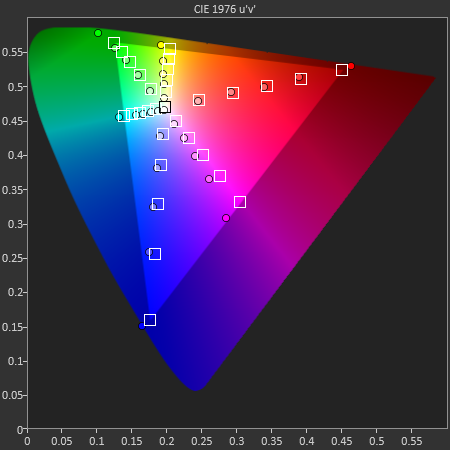
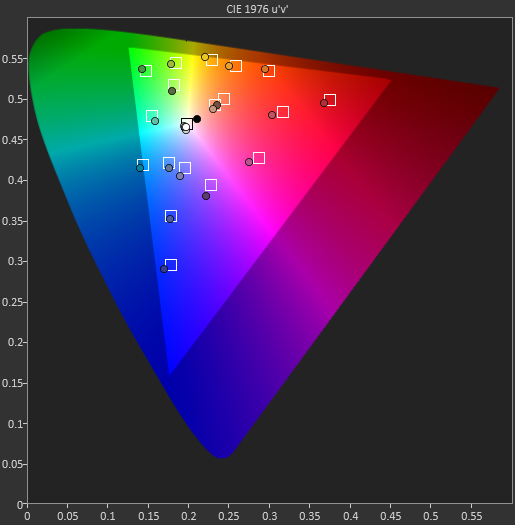
Because "Movie" was the closest to sRGB of all the modes, I selected it for the actual results that I'll present in the table. Admittedly this mode does tighten things up a bit, but it still isn't perfect and I'd still like to see Samsung do something to reign this in at some point.


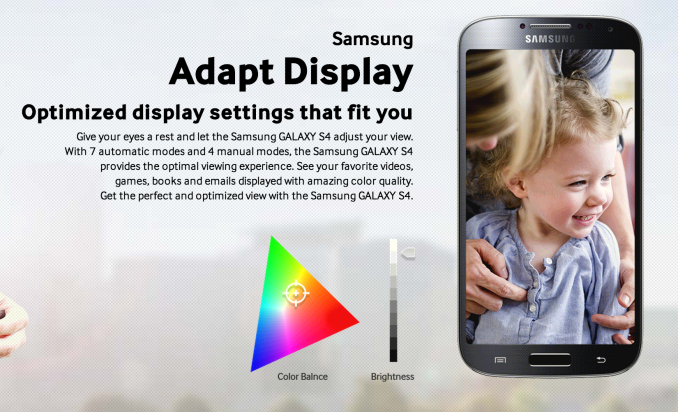




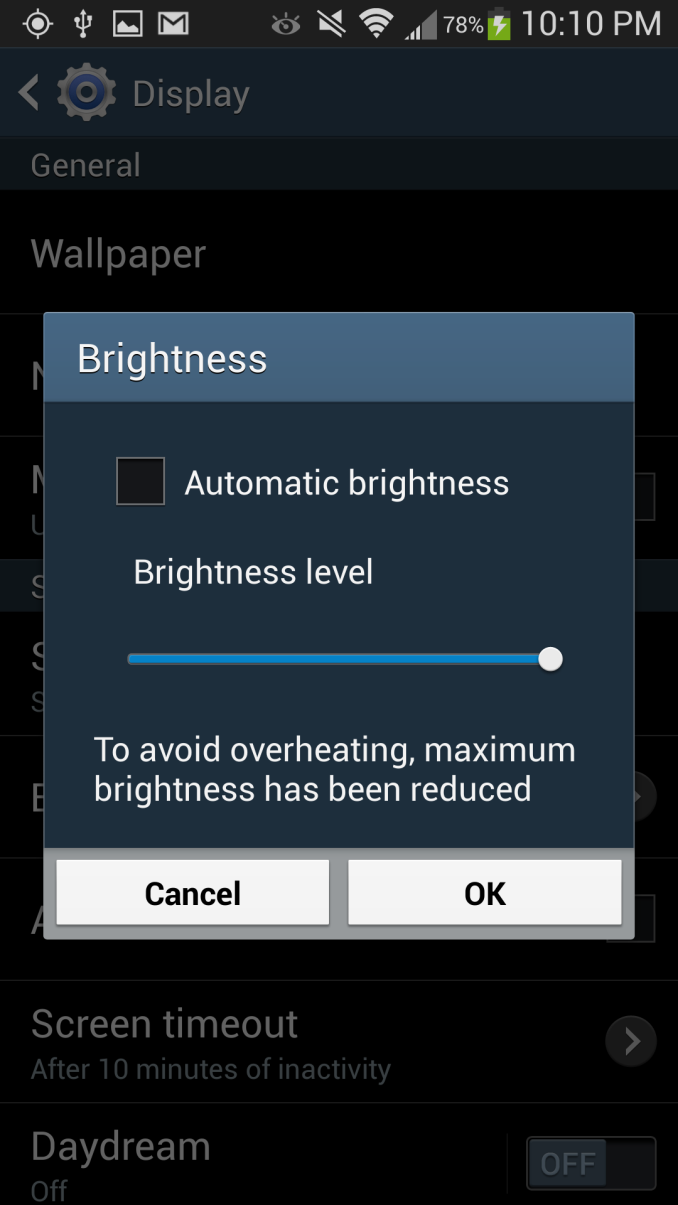
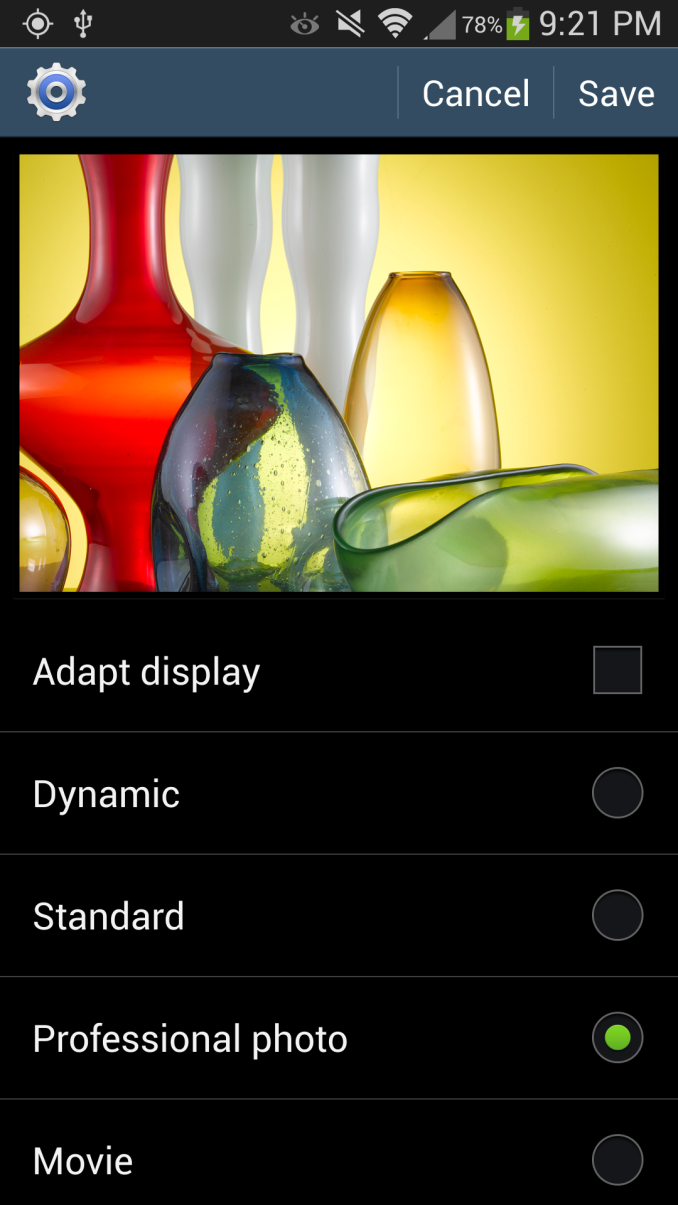
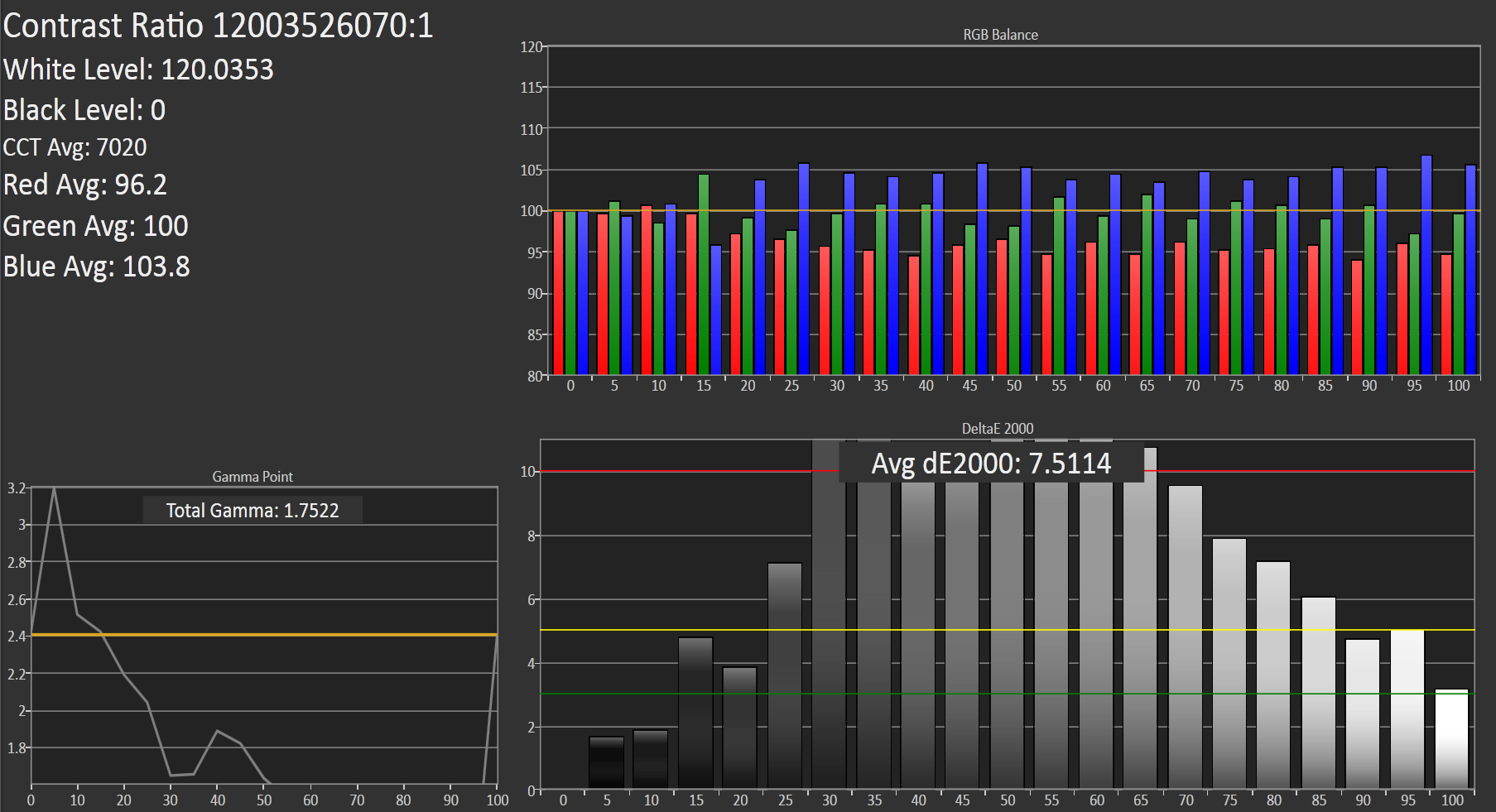








335 Comments
View All Comments
sigmatau - Thursday, April 25, 2013 - link
Oh and I own a Nokia 900 and am looking to go back to Android. My phone works great. The email is perfect, never a crash, and the UI is smooth and flood. What is lacking is software. I just bought a Camaro and can't even use the OnStar app for it. The battery could be better and the camera isn't the best. For work, though, it is perfect. Email and IE is tops for my job. Not sure why portal websites still don't work as well on Android. I, also don't understand why the screen (OLED made by Samsung) is unreadable in sunlight.Hrel - Wednesday, April 24, 2013 - link
Wow, what's with all the hate on Sprint? Even camping in Wisconsin I have service on Sprint. Who cares if the phone is made of metal or plastic or cow dung? You should ALWAYS be putting your smartphone in a case, ALWAYS! So I say use the cheapest durable material possible. Since it's ALWAYS in a case, it's fine. If you aren't putting your 600 dollar+ phone in a case NO, you are WRONG, it ALWAYS goes in a case, ALWAYS!MilwaukeeMike - Wednesday, April 24, 2013 - link
Alright, I had to jump in here... I'm a sprint user in Wisconsin and their network is terrible. They are the only major carrier who's speed tests must be measured in kpbs instead of mbps to avoid the heavy use of decimals. He put a caveat on the review because a slow network makes the phone work longer and hurts battery life and because Sprint's network is so much slower, you'll see much better results from other networks. He made the right choice to leave out a 3G browsing graph because it wouldn't be an accurate showing of the phone's battery life.... especially since his other phones are on other (better) networks.You do realize some people care about materials... if you don't, fine use a case. but if you do care, then the metal phones are nicer. Apple's had success with their metal phone too you've probably noticed.
Hrel - Wednesday, April 24, 2013 - link
Apple had success because it's Apple. People who buy Apple buy Apple, they could release a phone powered by human blood and people would buy it. If you live near MIlwaukee or Green Bay then I'm not sure what you're talking about. If you live podunk then yeah, you need Verizon. But Verizon is 110/month. Virgin Mobile (Sprint) is 35/month. I'll take a slower network over 900/year.dolo4delf - Wednesday, April 24, 2013 - link
I have an Ipod Touch...love it....would not buy an Iphone though...kyuu - Wednesday, April 24, 2013 - link
No, you are wrong. Do what you like with your own phone, but I'm not putting mine in a case -- adding extra weight and thickness, ruining the in-hand feel, or covering up the exterior -- because you say so.And no, I don't own an iPhone.
sigmatau - Thursday, April 25, 2013 - link
Go shove your case! You are wrong! If your phone needs a case, than it is a sorry POS. The only case I've had for a phone was a terrible Samsung phone. Not for a blackberry, not for an iphone, not for my Nokia 900. So you are wrong. Put your laptop in a case when you use it.gnx - Wednesday, April 24, 2013 - link
Glad to hear the camera is an upgrade. Looks like Sammy was primarily concerned about comparison with the Iphone5, focused on pixels, aperture, software enhancements (including aggressive night mode), etc. I have to admit, since I take photos oft in well-lit situations, outdoors and indoors, and don't take photos with friends in low-light bars often, this is what I'm looking for as a daily driver. Also, less noise in background colors is an important plus for me, since I blow up parts, and crop out others for the optimal photo to share.Hopefully Klug will update his review when he gets a hand on the international Exynos Octa version? I'm going for that one, even if I have to lose LTE, since it's more useful for travel abroad, and hopefully will have better CPU/GPU performance and maybe battery too. I don't think there's been a actual customer product with ARM's Big.Little architecture (Exynos Octa being a variant), so I'm looking forward to an analysis by Anandtech on that.
Battery is my third concern, but when you can buy a spare battery and chargers that charge both the phone and the battery at the same time, it becomes a mute problem.
AMOLED is always something of a hate-love relationship. It's oversaturated and power-hogger in browsing mode (cause of the white background), but I have to admit, unlike a laptop or desktop screen, in the relatively cramped phone, it does make the screen pop-out more. Especially with the minimal bezel on this SGS4! I remember each time I'm in carrier stores, the AMOLED screens really catch one's eye when side by side with a LCD screen, even though under further use, the LCD seems to have better clarity, even it it seems subdued. But what I really want to know is if the AMOLED tech used on this SGS4 has matured enough that we don't need to worry about gradual burn-in, which was a real problem in older AMOLED screens.
Touchwiz is still too chaotic for me, but at least I can always install a custom launcher. Just wish they provided an optional color theme for settings, etc, but that's probably asking for too much. At least, if this sells well, we'll have ample support from XDA developers.
Plastic is the bummer here. Gees, is it really impossible to build removable batteries and sd cards without resorting to plastic? My originally HTC Nexus One had a removable backcover. Surely, Samsung can do something close too? (No?) Or has Apple cornered so much of the aluminum supply, that it's prohibitively expensive and detrimental to timely large scale production? (as some Sammy sources imply?) Can't help wondering, with the competition from the HTC One, the next Note III due this fall will have a metal or some other upgraded case.
In anycase, further reviews on international SGS4 models with different parts, and updated reviews for the HTC One with US carriers and updated software would be appreciated!!
Thanks, Anandtech!!
BestPal - Wednesday, April 24, 2013 - link
Brian, you guys always do the best reviews, thanks!Y'all also do the most technically comprehensive reviews too, which is great for us gear heads :)
In that vain, and since you have the Sprint variant, I would like to ask a bit of a technically curious question I have about the Sprint variant...
Sprint is now finally going back to using removable SIMs on their GSM-capable devices, which is awesome for folks who travel overseas. Even better, Sprint is fairly liberal about unlocking their devices, albeit with having the OEM modify the device such that it won't do GSM inside the US on US bands, which is a long-standing Sprint thing but is absolutely fine. The main thing is that it allows using the device with a foreign SIM outside the US. However, on this device Sprint appears to have had Samsung do something strange, which is even though the device passed the FCC with UMTS 850 in it, Sprint appears to have requested Samsung to disable it, EVEN FOR overseas usage, leaving it with only UMTS 1900 and 2100. For those of us who frequently travel to South America (and a bunch of other places in the world too), crippling that band for overseas use is very problematic. Any idea why Sprint did that? Since in Sprint's case that band won't be useable in the US anyway. Anyway, I can think of no good reason to do this.
antef - Wednesday, April 24, 2013 - link
Samsung doesn't know how to do UI and they prove that with every phone or tablet they put out. TouchWiz is like Windows XP and IE6 with a million extra toolbars installed. The hardware menu key is awful and if they stopped and thought about it for a few moments they would realize why it's bad for new users, the platform, and those switching between tablets and phones. As the owner of two Samsung Nexus devices, I think they're hardware is great, but they can't get it together with usability and UI.